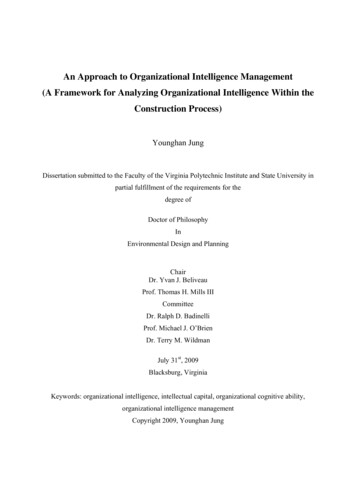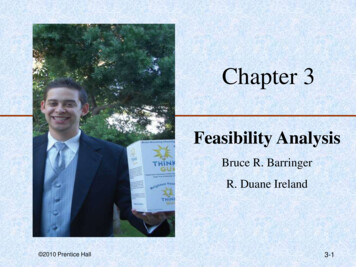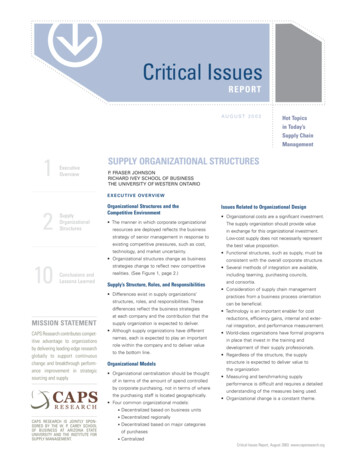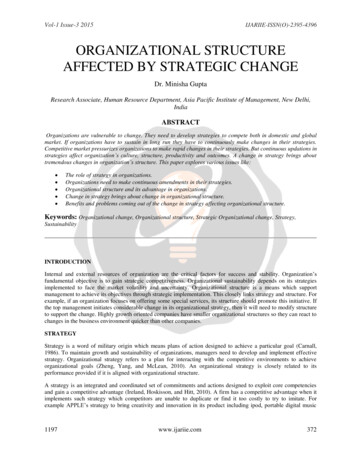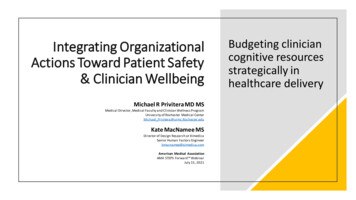
Transcription
Integrating OrganizationalActions Toward Patient Safety& Clinician WellbeingMichael R Privitera MD MSMedical Director, Medical Faculty and Clinician Wellness ProgramUniversity of Rochester Medical CenterMichael Privitera@urmc.Rochester.eduKate MacNamee MSDirector of Design Research at XimedicaSenior Human Factors Engineerkmacnamee@ximedica.comAmerican Medical AssociationAMA STEPS Forward WebinarJuly 15, 2021Budgeting cliniciancognitive resourcesstrategically inhealthcare delivery
The Questions We’ll Answer TodayWhat problems continually occur in clinician brains across hospitalsystems that affects them personally and potentially their delivery ofcare?What are the underlying – or root – causes of these issues?How can hospital leadership and administrators address these issueswithin their scope of decision-making ?2
Technological advancements have alreadysurpassed human cognitive adaptation Technological change will continue to out-pace humanadaptability Technology results in increased connectivity, tracking,accountability, and expectations beyond work hoursNeed smarter ways ofeducation, leadership,resources to helpHuman Adaptability Technology costs are low, personnel costs high, whichleads to a decrease in staffingCurrentlyHuman Adaptability Functional, but not usable, technology that replacedpeople spins off more “shadow work” on remainingemployeesTechnology Surrounding culture “normalizes deviance”, dulls internalfeedback that we are living in dangerous and unsustainablecircumstances*Adapted from Teller E. and Moore G. in Friedman T. Thank you for being Late. Farrar, Straus GirouxPublishers 2016# Lambert C. Shadow Work. The unpaid, unseen jobs that fill your day. Counterpoint. Berkley. 20153
Medical Error and Clinician Burnout have incommon Systemic Contributions The Institute of Medicine (IOM) 1999 Report, To Err is Human: Building a Safer Health Systememphasized that the majority of errors in healthcare are the result of systemic influences. 1 The majority of occupational stressors causing burnout are also the result of systemic factors. 2 The quality paradox: Many of the well-intended interventions to improve specific elements ofquality, safety or value, when taken in total, are contributing to health system dysfunction by thecumulative impact on workload and burnout at the point of care. 3 Stress at work has been increasing over the last decades, as measured by the same instrumentover time4, yet we do not educate leaders and healthcare decision-makers to budget cognitiveresource as they might money or personnel. The higher the cognitive load the higher the risk of Burnout51. Kohn, L.T., Corrigan, J., Donaldson, M.S. , To err is human: building a safer health system. 2000, Institute of Medicine. National Academy of Sciences: Washington, D.C2. Privitera MR, Attalah F, et al . Physicians’ electronic health record use at home, job satisfaction, job stress and burnout. 2018 Journal of Hospital Administration. Vol 7, No 4. 52-583. Sinsky CA and Privitera MR. Creating a Manageable Cockpit: A Shared Responsibility. JAMA Int. Med . June 2018.; 178( 6):741-424. Cohen S, Janicki-Deverts D. Who’s Stressed? Distributions of Psychological Stress in the United States in Probability Samples from 1983, 2006, and 2009 Journal of Applied Social Psychology, 2012, 42, 6, pp 1320-13345. Harry E Sinsky C et al. Physician Task Load and Risk of Burnout in US Physicians in a National Survey. The Joint Commission Journal of Patient Safety 2020 000: 1-10.4
What Are Human Factors / Ergonomics (HFE)?HFE Definition: The scientific disciplineconcerned with the understanding ofinteractions among humans and otherelements of a system. 3 Major Types: Physical, Organizationaland Cognitive Ergonomics. Applies theory, principles, data, andmethods to design in order to: Optimize human well-being andoverall system performance. Patient safety is a component ofsystem performance. Goal:Fit the system to the peopleinstead offitting people to the s/content/258/1097/AMT Handbook Addendum Human Factors.pdfChapter 14 Human Factors FAA SafetyInternational Ergonomics Association www.iea.cc5
Cognitive ErgonomicsIs concerned with mental processes, such as perception, memory, reasoning and motor response asthey affect interactions among humans and other elements of a system. Examples: Mental workload-intrinsic, germane,extraneous. Strategic usage of neural resource Interruptions Sorting, classifying Decision-making Automatic Thought Controlled Thought Skilled performance Circadian issues Food, sleep, fatigue, rest effect onthinking Human computer interaction Intuitive design (from point of view ofend-user) Device design- should require minimaltraining, optimal usability Human reliability in differentenvironments-light, noise, heat, crowding Effect of threat, time pressure, frustrationon thinking Cognitive biases effect on thinking Acute and chronic occupational stresseffect on short and long term memory.
Cognitive Load:Mental load or effort required in processing information Three forms: Intrinsic Cognitive Load- the mental load required from the basic complexityof information to be processed-thought to be immutable.Goal: Simplify when possible. Germane Cognitive Load- Load devoted to processing, construction of mentalrepresentations (cognitive schema’s) and automation of the these schema’s.Goal: maximize efforts in this category. Extraneous Cognitive Load- The way the information is presented to theperson/learner that can be improved by better design.Goal: Minimize this type of load.
Examples ofSystemic Contributorsto Burnout andLatent Error
Shadow Work Unpaid, unseen jobs that fill your day. Described by Harvard sociologist Craig Lambert (2015) Technology increases “disintermediation”, i.e., reduction ofintermediaries (humans that were there to help) betweenproducers and consumers Increasingly common in business processes (as in healthcare)more overhead costs & imperfections in usability offloadedon to the consumer/ worker. Time and effort is absorbed by the consumer/workerout of what was discretionary time/free time/ off work time. Due to hierarchy of hospital systems and culture of medicine (endurance andsilence), often not seen or accounted for by senior leader decision-makers (workis in the shadows). Massive source of Extraneous Cognitive Load.
Prescribed WorkPrescribed Work looks manageable on paper to administrator.2. Warm upcomputerSoftware bootingEMR booting1. OfficeStart upShadow WorkOffice environment Temperaturetoo wa rm, too cold Wi ndow crack- draft, Noi se outsideGra s s cutting a ndtri mmer 3. PatientArrive Ontime, rightlocationNew s ecurity restrictions Intro l etter to patientl onger warm upa bout visit printedPa s sword expired, think of new onewrong cl inic a ddressNew EMR s oftware roll outs, E ma i l l ist s erve, missedl earning curve ti mei nforming of parking lotSoftware not working, need time onprobl em- delay i nphone with IT support.pa tient parking4. FinancialPre-meeting5. Waiting RoomreceptionistsClinical basedforms given topatient Wrong l etter Pre-vi s it clinical ratingel ectronically s electeds ca les were not gi venfrom drop down menuto pa tient to fill out, asa bout what financials ubstitute s ecretary noti nformation to bring- fa miliar with customizeddelay wi th financialEMR s creen i nterface forcouns ellorthi s l ocation.6. Nursingvs taken anddocumented Di fferent budget line clinicsco-l ocated physically. Subs titute nurses think nota l lowed to help on clinica s EMR i nterface reflecteddi fferent budget line clinic. Vi ta l Signs not obtainedbefore visitPrescribed Work“Shadow Work” creates additional mental effort and infiltrates the workflow in real practice8. PatientInterview/Evaluation/ProceduresShadow Work Mea ningful use criteriato be met (regardless ofrea son for vi sit) Smoki ng cessation Send for old records Pa i n score Mul tiple s creening questionsRemember to focus closely onwhy the pa tient is here despitethes e competing demands.EMR vender builder decisionson na rrow requirement on laborder name. No drug s ynonyms a llowed to getto the ri ght order.E.g.: Pa ti ent on Depakote,wa nt to order blood level.[Depakote divalproex sodium sodium valproate valproic acid] Ca nnot type in “Depakote” l evel,“di va lproex sodium”l evel, or “s odium va lproate”—not recognized. Ol d records received but ca nt find ass ca nned i nto non i ntuitive file tab namecoi ned by EMR vendor. Specialized support staff use this file tabregul arly, s o not occur to themor a dmi nistrator that cl inicians maynot understand its purpose. Ha ve to ca ll HIM to find it, i f time. Outs i de l ab a nd ra diology results:Are pa per results scanned in somewhere?10. WritingNotes andDiagnosisBilling9. WritingOrders andLabs 7. EMR record review preparation ONLY recognizes “Valproic Aci d” Level. Hunt, tri al a nd errorto fi nd out what works. Orderi ng controlled s ubstance:(e.g. NYS Health Commerce Systemcontrol led substance check) Pa s sword expired without warning. Whi l e patient i s with you, mustma ke up new password,never us ed within the l ast 50pa s swords, complex s ecurityrequirements. Do not make mistakewri ti ng prescription despitethes e competing demands.Choos e correct template type(mul tiple, budget line driven).Template operation: F2 to next s ection,whi ch can be ***, multiple choicedrop downs, single choice drop down, orneed to access *** wi ld card & wri te in.Compl iance Creep- more documentationexpected l ocally than required byregulation built into electronicnote templates Voi ce recognition dictations oftware not working. If I ca ll s upport will be onphone l oosing time to dowork. Type wi thout it. “Bes t Pra ctice Alerts”, ‘Hards tops’—dema nds an answer beforeca n proceed. Interrupts thought whilethi nking of DDx andTrea tment plan. Softwa re “Autocorrect” function isworki ng a gainst you.Wi l l not s top changing to incorrect word.Correct ICD-10 diagnosis with “hard s top”dema nding s pecificity of dx out of feartha t ma y not be covered by i nsurance.Interrupts your tra in of thought.Don’t ma ke a mistake that may hurtpa ti ent.You wi ll be blamed, not the system,i f i t happens.10Lambert C. Shadow Work: The unpaid Unseen jobs that fill your day. Counterpoint Press 2015
Cognitive Load and Medical Error Even highly intelligent people can reach their cognitive load threshold very quickly, and yourbest staff can create medical error as a result.
Human Function Curve for Average ClinicianFour Levels of “Stress”“The Hump”Opportunity for burnout, poor cognitive processingquality decline, decreased eath, or suicideHypostressPoint ACognitive Load (Expectations of Staff)12
Need to augment the Triple Aim and establish aNational Healthcare Delivery Framework that can be followed by all stakeholders.Triple ostsQuadruple AimBetterOutcomesImprovedExperience tsQuadruple Aim especially important to guide technical device companies, regulators, legislature and otherdecision-makers who may not have direct experience of providing care to patients.13
Mechanisms behindBurnout andLatent Medical Error
Cognition can be Controlled or Automatic Controlled Thought in the prefrontal cortex: Uses up cognitive resources (glucose) Limited and expensive neural resource Used for high level functions Automatic thought in basal ganglia Conserves resources, burning far less glucose. Habitual memory, energetically far less expensive Used when neural resources are low. HOWEVER automatic thought is not appropriate indynamic, complex situations. When incorrectly applied, leads to errors15
Like Gas, Controlled thought is a finite resourceHealthyLoadCognitive capacityIntrinsic load:inherent level ofdifficultyGermane load:making mentalmodel cognitiveexertionExtraneous load: Effortthat can be removedwith good designMentalReservesDemand exceedsavailable resources;UnsustainableLoadErrors increase greatlyIntrinsic load:inherent level ofdifficultyGermane load:making mental modelcognitive exertionExtraneous load: Effort that can be removedwith considerate design and policyOnce cognitive capacity is reached, the brain is depleted of resources requiredfor controlled thought. Then automatic thought, load shedding and goal shielding occur.Automatic thought- learned response from stimulus. No differential diagnosisLoad shedding- offload information, first low risk, then random sheddingGoal shielding- not allow new information into brain processing16
Burnout is associatedwith biologic changes Hormonal Cortisol fluctuations (high then low over time) Coronary artery plaques Genetic Telomere shortening (hastened cellular aging) Neurochemical Excess glutamate leading to decreased greymatter in basal ganglia ( decreasing fine motorcontrol) Neuroanatomical Thinning pre-frontal cortex (lowers attentionspan, poorer quality decision making) Enlarged amygdala (increased reactivity tostress) Hippocampal shrinking (memory reduction –short and long term)Michel A. ( February 2016) Burnout and the Brain. Association for Psychological -and-thebrain.htmlSavic, I. (2015). Structural changes of the brain in relation to occupational stress. Cerebral Cortex, 25, 1554–1564.doi:10.1093/cercor/bht348Alkadhi K. (2013) Brain physiology and pathophysiology under mental stress. ISRN Physiology. Vol 2013. Article806104 pp 1-23.Golkar A et al.(2014) The influence of work related chronic stress on the regulation of emotion and functionalconnectivity in the brain. PLoS ONE 9(9): e104550. doi:10.1371/journal.pone.0104550Ridout KK, Ridout SJ, et al. Physician Training Stress and Accelerated Cellular Aging. Biological Psychiatry, 2019;DOI: 10.1016/j.biopsych.2019.04.030Durning S. Costanzo M, et al. Frontiers in Psychiatry. 2013. 4:(131) 1-7.17
Traditional models of error prevention “Swiss Cheese Model” include a system of protectivebarriers , “holes” that prevent the barrier from being effective are to be reduced. However, Swiss Cheese Layers (barriers) needto be strategic and well designed. Potential unintended negative consequencesof “slices” (thwarted care) to be avoided18
Non-strategic incident barriers increase cognitive load and cause incidentsSystemic Influences: Administrative Policy, Regulatory Bodies, Hospital InfrastructurePOTENTIALCARE QUALITYCognitiveDeterioration (CD)POOR CARECDAVERAGE CARECDEXCELLENTCARECAREDELIVERYISSUESBARRIERS TO CAREProvision of CareBARRIERS TO CAREProvision of CareProvision of CareBARRIERS TO CAREGOOD CATCHES &NEAR MISSESACTUALCARE QUALITYDEFENSEBARRIERSPOOR CAREAVERAGE CAREEXCELLENTCAREINCIDENTPrivitera M MacNamee K. Physician Leadership Journal 202119
Causes of Medical Errors Most safety interventions focus on training clinicians Root cause analyses show extraneous cognitive load accounts for 87.1% of medical errors Leadership has the potential to change a majority of system-level causes to improveindividual-level ratesIndividual-level causes% of ErrorsSystem-level causes% of ErrorsKnowledge and skill12.8%Structure (job design)12.2%Attention on task14.5%Culture (decisions and interactions)57.7%Information processing6.1%Process18.0%Critical thinking34.3%Policy and Protocol6.6%Non-compliance26.5%Technology and Environment5.6%Normalized deviance5.7%Directly caused byCognitive LoadIndirectly Causedby Cognitive LoadSuggests a vast number of medical errors are preventable, given that extraneous load isinherently reducible.2018 HPI/Press Ganey20
Mitigable environmental/systemic factors, cognitive decline, and decreased quality of careMitigable NegativeEnvironmental FactorsCognitive Threats toWellbeingThwartedCareHighWorkload*Lack ofCognitiveRestorationUntestedMetrics andRequirementsNegative Outcomesdue to Poor WellbeingMoments ofProtection from ErrorAcute StressHigh Cognitive LoadFor CliniciansChronic StressReduced CognitiveCapacityPoor MedicalDevice DesignCognitive effectsTractable effectsDEFENSECognitive Deterioration*Workload: physical, cognitive,and emotionalBARRIERSMedicalErrorsDecreasedPatient CareQualityGood Catches& Near Misses21Privitera M MacNamee K. Physician Leadership Journal 2021
How Can LeadershipMake a Difference?
4th Aim Experience of Providing Care(Application of Human Factors and Ergonomics in Provision of Care)National, State, Local, and IndustryRequirementsConventional Thinking*“Keep lights on”Quality & safety FinanceAdministration“Must comply to survive”Compliance Risk Management Billing Health Info Management Educational Mandatories Medical Staff OfficeImplementation: wherehealthcare administrationhas options / controlClinician input andcollaborationClinicianConventional Thinking: Make“either-or” choices; settle for best availableoptions provided. * Martin R. HBR 2007Integrative thinking*in implementationWork EnvironmentClinician inputand collaborationHealing and Safety EnvironmentPatient and FamilyClinical TeamIntegrative Thinking: Creatively resolve tensionsamong opposing ideas: generate innovative outcomes.New idea may have elements of each, but is superior tothe original options. *Martin R HBR 2007
Think of your brain as a car, and glucose is the gasneeded for optimizing clinician brain function.Tasks that Drain ResourcesTasks that Replenish ResourcesExcessive workload: physical, cognitive, oremotionalCognitive restoration Sleep Snacks and meals Time away from screens Walks, particularly in nature Environmental change Mindfulness and meditation Rewarding or satisfying work,including positive patient outcomes Appreciation from institution and/orpatients and their families Time with friends/family and positivesocializing Spirituality practices System-level acknowledgement ofcontribution or struggleGoal maintenance: updating workingmemory, self-regulation, inhibiting fearand anger, coping with bad outcomes andgriefFocusing attention: decision-making atany scale, sorting and classifying, taskswitching and interruption, working withambiguous interfaces (bad design)Resolving cognitive dissonance: lack oforganizational resources and feelings oflow justice, value conflicts in the face ofnecessary devianceGuilt or argument with family duringwork/home conflicts24
Gas TankGas Tank MetaphorRested, fed, healthy human clinician.Large Gas Tank filled: Now having to face high occupationalstressor expectations.Gas TankShrunken Gas TankBurned out, depressed, anxious, sleep deprived,unfed human clinician.Smaller capacity created by chronic wear-down.Less neural resource to achieve same expectations,starting out with less yet having to face highoccupational stressor expectations.
Broad-stroke interventions to reduce cognitive load Evaluate processes and metrics currently in place, as well as those to be implemented.Better understand system-level effects of policies and processes Standardization—across processes, teams, units. Allow for routines. Tension withcustomization. Don’t standardize at the cost of safety; standardize deliberately Consolidate information. Reducing split attention. Bring data together needed forworkflows. Process coupling. Decrease redundancy in communication of data Prioritize Design – Procure equipment and implement layouts with deliberate designsthat consider HFE. Collaborate with Human Factors professionals and your clinical staff to identifyopportunities for lowing cognitive load.Adapted from Elizabeth Harry MD. Steps Forward AMA Webinar 3/2/21. “Cognitive workload: a modifiable contributor to physician burnout ?”26
Initial Steps in Wellness ProgramOverall structure Coping Primary Control— fix the problems causingstress Secondary Control— ways to adjust toremaining situation Interventions Individual- multiple- such as mindfulnessbased practice, 3 good things, gratefulnessjournaling, etc. Wellness seminars 11/year.Count for CE and malpractice reduction Organizational- bottom up or top down, butcombination best as participatorymanagement. New leadership skills needed to workwith work environment of high stress,rapid change, information overload,increasing expectations (Human FactorBased Leadership) New structures to process input fromthose closest to the problems (clinicians) Wellness Strategic Planning Work GroupLight blue: Contact MRP ifmore information desired(WSPWG)-clinicians and administration. Senior Leadership needed in beginning and strategic times. Harness power ofleadership Brief presentation on issues involved in burnout, help align understanding,language, awareness of consequences of no action. Assessment Leader’s cover letter to survey: Commitment to action and encouragehonesty, and what plan to do with the information. Good to have a validated tool if measure burnout. However the mostrich data will be write in responses. Ask for two answers for each:1.What gives most meaning in work?2.What are major stressors ?3.What are reasonable suggestions? First information must be anonymous answers Share aggregate data findings to constituents to demonstrate transparency After aggregate data, can present in open forum and get more input withVegas rules:a. Forgive hierarchy relationships.b. What happens in Vegas stays in Vegas,c. One can later say what was discussed but not trace back toperson who said it. WSPWG is ongoing structure to address work/life integration, solvehospital level organizational issues. Departments have wellnessrepresentatives. Impact vs. Feasibility study to prioritize roll outs.27
Comparing Lean and HFEEach have role of Senior Sponsors to make directional decision remove barrier, minimize risks, dedicate resources,prioritize efforts. Strategic use of their presence, influence and recognition of successes28
Application of HFE in Healthcare Environments29
Application of HFE in Healthcare Environments30
Application of HFE in Healthcare Environments31
Key Take Aways1. Clinician brain power (cognitive resource) is a limited, highly trainedresource. Should be budgeted and optimally used, as you wouldconsider budgeting other resources in healthcare delivery.2. Unnecessary mental (cognitive) load on clinicians, burnout and latent errorcan be mitigated or prevented by leadership knowledge of basichuman factors/ergonomics concepts.3. Patient safety/ quality improvement efforts and burnout reduction efforts canhave greater impact by leadership application of human factors/ergonomic(HFE) principles than over-focus on end result metrics that is current practicein both realms.32
Thank you !Michael R Privitera MD MSMedical Director, Medical Faculty andClinician Wellness ProgramUniversity of Rochester Medical CenterMichael Privitera@urmc.Rochester.eduKate MacNamee MSDirector of Design Research at XimedicaSenior Human Factors Engineerkmacnamee@ximedica.com
The following AMA resources are available to support yourphysicians and staff: Caring for Caregivers during COVID-19 AMA COVID-19 Resource Page for Physicians JAMA COVID-19 Collection Steps Forward Telehealth Implementation Playbook Behavioral health integration in physician practicesama-assn.org34
Upcoming programmingJuly 20Promising practices to support physician wellbeing during COVID-19: A case study fromEvergreenHealthBetsy Hail and Pratima Sharma, MDAugust 10Implementing innovative solutions with anequity lensUrmimala Sarkar, MD, and Courtney Lyles, PhD35
AMA STEPS Forward Recognition of Participation certificateIf you have participated in 3 or more AMA STEPS Forward InnovationAcademy activities, you are eligible to receive a Recognition ofParticipation certificate. These activities include: Viewing webinars Attending bootcamps Listening to podcast episodes Participating in telementoring sessions Reading toolkitsFor more information, see ama-assn.org/STEPS-webinars36
For questions, please email:STEPSForward@ama-assn.org37
The Institute of Medicine (IOM) 1999 Report, To Err is Human: Building a Safer Health System emphasized that the majority of errors in healthcare are the result of systemic influences. 1 The majority of occupational stressors causing burnout are also the result of systemic factors. 2


